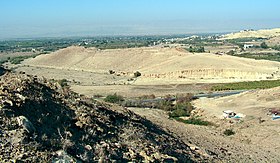Abila (Peraea)
Abila (Arabic: ابيلا) was an ancient city east of the Jordan River in Moab, later Peraea, near Livias, about twelve km northeast of the north shore of the Dead Sea. The site is identified with modern Abil-ez-Zeit, Jordan. There is a widely supported theory that in the Hebrew Bible, it is referred to as Abel-Shittim, as well as in the shorter forms Shittim and Ha-Shittim.

Biblical Abel-Shittim
Abel-Shittim, Hebrew meaning "Meadow of the Acacias", is found only in the Book of Numbers (Num. 33:49); but Ha-Shittim (Hebrew meaning "The Acacias"), evidently the same place, is mentioned in Numbers, Joshua, and Micah(Numbers 25:1, Joshua 2:1; 3:1, Micah 6:5). It was the forty-second encampment of the Israelites, associated with Israelite cultural integration and inter-marriage with the Moabite residents, the heresy of Peor and the Covenant of Peace according to which God recognized the zeal of Phinehas and the permanence of the Aaronic priesthood (Numbers 25:1-14). It was also the final headquarters of Joshua before he crossed the Jordan.
The location is translated as Shittim in the Geneva Bible, Jerusalem Bible, King James Version, New International Version and New Revised Standard Version. The Complete Jewish Bible and Orthodox Jewish Bible both translate as Sheetim. The Good News Translation has Acacia Valley and the New King James Version has Acacia Grove.[1]
Josephus' Abila (1st century CE)
Josephus[2] stated that there was in his time a town, Abila, "full of palm trees", at a distance of sixty stadia[3] from the Jordan, and described it as the spot where Moses delivered the exhortations of Deuteronomy. It is claimed that to this day an acacia grove is not far from the place, although palms as mentioned by Josephus are not to be found. Perhaps Josephus or his sources did not distinguish acacia from palms.
Abel-Shittim is identified with the area around Tall el-Hammam, in the Late Bronze Age.[4]
During the First Jewish-Roman War, Abila was captured by the Roman Imperial army, and was used by them to resettle deserters who had joined the Roman ranks.[5]
Notes
- All translations except Jerusalem Bible are taken from Bible Gateway www.biblegateway.com, accessed 27 June 2015
- Flavius Josephus, Antiquities of the Jews, iv.8, § 1; v.1, § 1
- 9 kilometres (6 mi)
- William M. Thomson, The Land and the Book: Lebanon, Damascus, and Beyond Jordan, vol. 3, 3 vols. (New York, NY: Harper & Brothers, 1886), 3:669; Nelson Glueck, Explorations in Eastern Palestine II, AASOR 15 (New Haven, CT: ASOR, 1935), 378; Nelson Glueck, “Some Ancient Towns in the Plains of Moab,” Bulletin of the American Schools of Oriental Research 91 (1943), 15; J. Maxwell Miller and Gene M. Tucker, The Book of Joshua, The Cambridge Bible Commentary of the English Bible (Cambridge, MI: Cambridge University Press, 1974), 199; R. K. Harrison, “Shittim,” ed. Edward M. Blaiklock, New International Dictionary of Biblical Archaeology (Grand Rapids, MI: Zondervan, 1983), 413; Rami G. Khouri, Antiquities of the Jordan Rift Valley (Manchester, MI: Solipsist, 1988), 76; Burton MacDonald, East of the Jordan: Territories and Sites of the Hebrew Scriptures, ed. Victor H. Matthews, ASOR Books 6 (Boston, MA: American Schools of Oriental Research, 2000), 90
- Josephus, De Bello Judaico (The Jewish War) 4.7.6 (4.437)
References
- Richard Talbert, Barrington Atlas of the Greek and Roman World, (ISBN 0-691-03169-X), p. 71.
- Attribution

